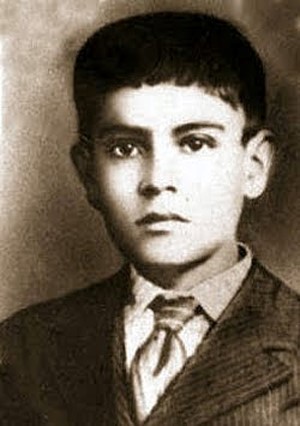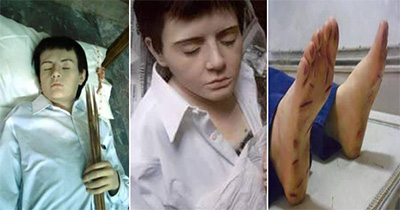
Long live Christ the King! Testimony of a child martyr
Monday, October 3, 2016
*Rogelio Zelada
The clouds, filled with shame, made sure the moon’s glow would not witness the horror of that night. The mock trial had taken place right in the sacristy of the parish church of Sahuayo. Those were times of pain, sacrifice and death, where the heroic testimony of Mexican Catholics defending their faith in Christ and their love for the Virgin of Guadalupe flourished during the horrible religious persecution unleashed by the dictatorship of Plutarco Elías Calles.
These fierce attacks against the Church and its believers lasted from 1926 to 1929. Facing a military armed to the teeth, simple and humble peasants, young members of Catholic Action, and common people of deep faith defended their right to profess the freedom and faith of the Catholic Church.

Photograph of Jose Luis Sanchez del Rio.
In the sacristy of the parish church, turned into a dungeon, José Luis Sánchez del Río, along with a young man named Lázaro – another Catholic militant – awaited the revenge of General Anacleto Guerrero.
José Luis was born into a working poor family who lived the Christian values; charity was the common practice of all the members of the household. From his parents, he inherited a solid piety and, since his first Communion, he had discovered the joy of a deep friendship with Jesus Christ.
He was born in times of violence and power struggles where shootings and the incessant movement of troops and revolutionary factions filled the land and the squares with the bodies of the dead from both sides. The people of the area, profoundly loyal to the faith and the Church, suffered frequent abuse from troops and army soldiers loyal to President Calles.
José Luis had just turned 14, but war and suffering had made him a man of integrity and courage before his time. He was captured on the morning of February 6, 1928, part of a group of Catholic activists the majority of whom, ambushed and outnumbered by forces loyal to Calles, had died in combat; the rest were immediately hung in the trees of the town square.
They spared the life of the militant child, thinking that they could scare him into abandoning his convictions, and his defection would teach a lesson to the Catholic people of Michoacán. However, the pressure, blows, insults and threats failed, so they tortured him, tearing the soles of his feet with bayonets, and forcing him to walk barefoot throughout the village towards the cemetery. His neighbors, frightened and helpless, witnessed in silence the horrible and bloody trek as the child cried in pain, constantly calling out to Christ the King and Holy Mary of Guadalupe.
From prison, José had managed to send a farewell letter to his mother:

Wax mold that covers the relics of Jose Luis Sanchez del Rio.
"My dear Mother: On this day, I was taken prisoner in combat. I think that I am going to die at the present time, but I do not care, Mother. Surrender yourself to the will of God; I die happy, because I will bravely die next to our God. Do not worry about my death, which is what mortifies me. Tell my two brothers to follow the example of their youngest sibling, and to do the will of God. Have courage and give me your blessing along with my father’s. Say hello to everyone for the last time and receive the heart of your son who loves you so much and longed to see you before he died. José Sánchez del Río."
They dragged him to the prison, hands and feet bound, but he managed to break free thanks to the guards’ carelessness. There, right in church, the soldiers had built a pen to guard their valuable gamecocks — an outrageous insult to the sacred enclosure that José Luis could not bear. In the darkness of the night and without any hesitation, he wrung the neck of the roosters; then he leaned back in a corner and fell peacefully asleep. In the morning, the soldiers insulted and threatened him, but he calmly replied, “The house of God is a place for prayer, not an animal shelter.”
That morning, his relatives were able to send some lunch. His fellow prisoner did not eat, but José, much younger than he, reassured him very calmly, “Take heart, Lázaro. Let’s eat well. They will give us time for everything and then they will shoot us. Don’t back down. Our sorrows last while we close our eyes.”
The military demanded an exorbitant ransom from the family, a fortune that José’s parents could never muster. That afternoon, he managed to write a second letter to one of his aunts:
“Dear Aunt: I'm sentenced to death. Tonight, at half past eight, the moment that I have so much desired will come. I thank you and Magdalena for all the favors you did for me. I do not feel able to write to my Mother; do me the favor of writing to her. Tell Magdalena that I got permission to see her for the last time and I don’t think that she will refuse to come (to bring Holy Communion) before martyrdom. Say hello to everyone, and you, as always and finally, receive the heart of your nephew who loves you very much ... Christ lives, Christ reigns, Christ commands. Holy Mary of Guadalupe. José Sánchez del Río, who died in defense of the faith.”
Beaten and scorned, with his feet gashed, he was forced to walk for hours on the stone pavement leading to the municipal cemetery. Standing on the edge of a grave, they told him: “If you shout 'Death to Christ the King,' we will forgive you.” But he said again and again, “Long live Christ the King!”
The soldiers, transformed into cruel executioners, stabbed his body to death until the leader of the troops finished him off by shooting him in the head with his rifle. Despite the noise of the shot, everyone could hear his last cry: “Long live Christ the King! Long live Holy Mary of Guadalupe!”
His exhumed remains were transferred to the crypt of the Mártires del Templo del Sagrado Corazón (Martyrs of the Church of the Sacred Heart), in the town where José Luis was born. On November 20, 2005 he was beatified by Pope Benedict XVI. Pope Francis will solemnly canonize him October 16 in St. Peter's Square, along Father José Gabriel del Rosario, known as “the Gaucho Priest,” from Argentina.
José Luis Sánchez del Río, a brave young heart, faced all the circumstances of the times in which he lived, and left us his testimony of a journey against all odds, a journey of loyalty and friendship with Christ. He is an example that the Gospel can and must be lived beyond all human possibilities.

